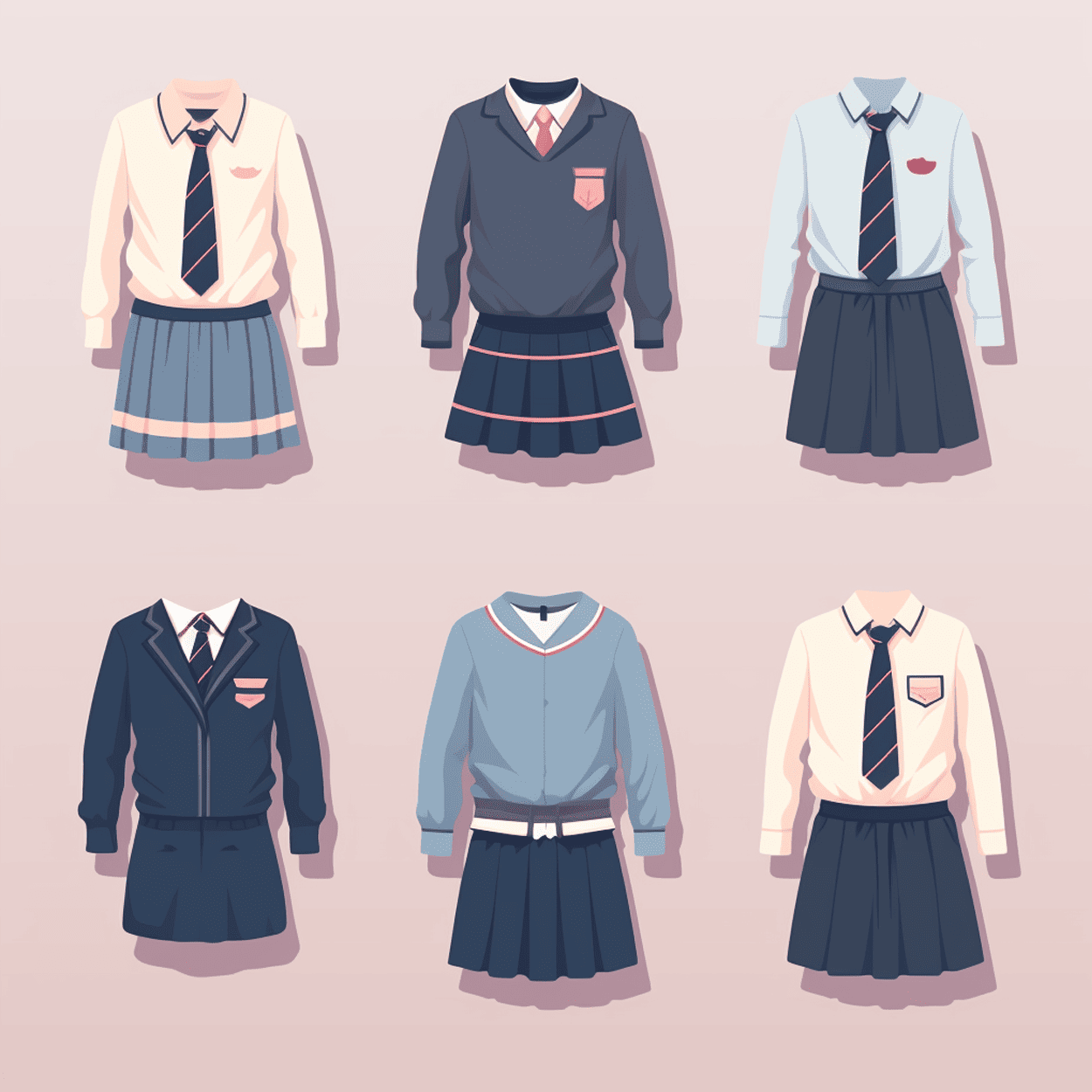Have you ever wondered why some schools require uniforms while others let you wear whatever you want?
It's a hot topic, and people have been arguing about it for a long time. Today, we're not just talking about whether uniforms look cool or not, but we're diving into the psychological impacts they can have on students.
Your school clothes might be doing more than just covering you up; they might be affecting your brain in ways you didn't even think about.
School uniforms are not just about what you wear; they can also influence how you think! In this article, we'll talk about:
- How uniforms can make everyone feel more equal but also less special
- Why they might make it easier to choose what to wear but harder to show who you are
- What psychologists and research tell us about this big school debate
So, put on your thinking cap—uniform or not—and let's explore what experts and studies say about the pros and cons of school uniforms.
School Uniform History

Around the 16th century in England, the first school uniforms weren't even for everyday students like most of us. They were made for charity schools, which were for kids who didn't have much money.
The uniforms were there to help everyone know which kids were from those schools. They were simple and plain, and they made sure everyone looked the same. But as time went on, more and more schools started using uniforms, not just the charity ones.
By the 19th century, the uniform trend had caught on in many other places, including the United States. But the reasons for wearing them started to change.
Schools started thinking: "Hey, if everyone's wearing the same thing, then no one can make fun of someone else's clothes." Or: "If everyone looks neat and tidy, then it's easier to focus on studying." It was around this time that schools began to see uniforms as a way to help students feel more equal and keep distractions away.
Now, fast forward to today. The idea behind school uniforms is kind of like a big salad with lots of ingredients. Some people think they're super helpful for keeping schools safe. Others believe they make it easier to get dressed in the morning without fussing over what to wear. And some just like how they look.
But not everything is rosy. Some folks argue, "Hey, I want to show who I am with my clothes. Why should I wear the same thing as everyone else?" This is especially visible in the way different cliques fit into stereotypes, such as the popular kids wearing bright colors and the goths wearing all black.
Others worry about how much these uniforms might cost, especially for families that might not have a lot of money.
As you can see, the school uniform journey is full of twists and turns, like a wild roller coaster ride. But one thing's for sure: it's not just about fashion; it's also about feelings, thoughts, and how we see ourselves and others.
The whole debate about uniforms also has some big brain stuff behind it. For example, psychologists—those are people who study how our minds work—have had a lot to say about how uniforms might make us feel. Some think they help create a team spirit, while others think they squash our creativity.
No matter which side of the fence you're on, there's no denying that the simple school uniform carries a lot of weight. From its early days in old England to its role in modern schools, the uniform has been a source of comfort for some and conflict for others. As we dig deeper into the pros and cons, we'll uncover even more about this age-old debate.
School Uniform Pros
1) Psychological Equality
First on our list is the idea that uniforms can make everyone feel more equal. When you see a whole bunch of kids wearing the same thing, it's tough to know who's got the coolest or most expensive clothes.
Dr. David Brunsma, a sociologist who has written extensively about school uniforms, suggests that this kind of equality can help lower the chances of kids getting picked on or bullied for what they're wearing.
Imagine you're playing a team sport. If everyone's wearing the same jersey, you're all focused on the game, not on who's got the flashiest gear. This is sorta what uniforms do in schools. They can help students focus on what really matters, like learning and making friends, instead of worrying about who's wearing what. This could make it less likely for students to get bullied for their clothes.
2) Reduced Decision Fatigue
Next up is a psychological idea called "decision fatigue." Ever felt tired from just picking your outfit in the morning? Well, psychologist Roy F. Baumeister talks about how making too many decisions can actually make your brain tired. Having a uniform takes away one choice you have to make, helping you save that brainpower for more important things like schoolwork.
3) Sense of Belonging
Here comes a heartwarming point: uniforms can make you feel like you're part of a team.
Dr. Angela Wright, who has studied the psychology behind uniforms, says that this sense of belonging can make students feel more connected and secure in school. Some research even shows that when kids feel like they fit in, they're more likely to be nice to each other and do well in their classes.
4) Fostering Discipline and Focus
Last but not least, let's talk about discipline. Dr. Alex Rentz, who has researched how uniforms impact student behavior, believes that wearing a uniform can help students focus better. It's like when a firefighter puts on their uniform; they know it's time to get serious and do their job. The same can go for students. That uniform is like a signal to your brain saying, "Hey, it's time to learn!"
So there you have it! These are some of the top reasons why people think school uniforms are a win. But hold your horses! It's not all sunshine and rainbows. In our next section, we're gonna look at why some folks think school uniforms are not so great.
School Uniform Cons

It's time to switch gears and talk about the reasons some people and experts give school uniforms a big thumbs-down. Trust us, it's not just about wanting to wear the latest fashion trends; it's a lot deeper than that, and it has a lot to do with how we think and feel.
1) Suppressing Individuality
Let's kick things off with one of the biggest arguments against school uniforms: they can squash your individuality. Dr. Christopher Lubienski, an education expert, says that uniforms can make it harder for students to express their unique personalities.
When you're stuck wearing the same thing as everyone else, you can't show off your personal style or let the world know a little bit about who you are.
2) Financial Strain
Next, we have to talk about money. Uniforms can cost a lot, and for families that are already tight on cash, this can be a big burden.
Dr. Elaine Schwartz, an economist who has looked into the financial aspects of school uniforms, points out that some families might struggle to pay for these mandatory clothes. And let's not forget about growth spurts; kids can outgrow uniforms quickly, leading to more expenses.
3) Contradicts Freedom of Expression
Now, let's get into some serious business: freedom of expression. This is something that psychologists like Dr. Alan Hilfer have talked about. He says that being able to choose your clothes is a way to express yourself and your opinions. In a country that values freedom, making everyone wear the same thing can feel like a big step backward.
4) Potential for Rebellion
Last on our list, believe it or not, is that uniforms can actually make some students act out. Dr. David L. Brunsma, who we mentioned earlier, also points out that some studies show wearing uniforms can make students feel like they're being controlled too much. And when people feel controlled, they sometimes do the opposite of what's expected, just to show they can.
So there you have it! These are some of the key reasons why some people aren't so hot on the idea of school uniforms. As you can see, it's a debate that brings out strong feelings and arguments from both sides.
Up next, we'll dive into what some important studies and theories have to say about all this.
School Uniform Theories
Let's move on to some studies and theories that have tackled the school uniform debate. These studies help us understand the nitty-gritty of why uniforms can be good or bad.
1) Social Identity Theory
First up, let's talk about something called Social Identity Theory. This was developed by psychologist Henri Tajfel, and it explores how people identify with groups.
When students wear uniforms, they're all part of the same "group," at least in appearance. This can create a sense of unity, but it can also make students feel like they're just one of many, losing their personal identity.
This theory helps us understand the balance between belonging and individuality that uniforms bring into play.
2) Self-Determination Theory
Another important theory is the Self-Determination Theory by psychologists Edward Deci and Richard Ryan.
This theory explains that people need to feel some control over their actions to be happy and successful. For some kids, being told what to wear every day might go against this need for personal control, which can lead to feeling unhappy or even acting out in rebellion, like Dr. David L. Brunsma mentioned in the previous section.
3) Empirical Studies
On the research front, there have been many studies, but let's focus on one by Dr. Jafeth Sanchez and Dr. George Mitchell. They conducted a study on school uniforms and concluded that uniforms didn't seem to significantly impact academic performance, but they did note some improvements in school climate, like fewer fights and less bullying.
4) Cost-Benefit Analyses
Last but not least, economists have done what's called cost-benefit analyses, where they weigh the good and bad sides of uniforms.
Economists like Dr. Elaine Schwartz, who we mentioned earlier, have said that the financial strain of buying uniforms might not always be worth the benefits they bring, especially for low-income families.
So there you have it, folks! From theories that dig deep into our need for belonging and control, to studies that look at how uniforms actually play out in real life, the uniform debate is chock-full of interesting angles. What we've learned is that there's no easy answer. Like a seesaw, the pros and cons keep tipping the scale back and forth.
School Uniforms According to Kids

It's good to know the formal theories, but let's hear from the real experts—kids themselves! After all, they're the ones wearing these uniforms day in and day out. What they say may surprise you!
They Like Being Treated Equally
Many kids actually like wearing uniforms because it levels the playing field. They say it stops "clothing competition" where some kids might show off expensive or fashionable items. In a way, uniforms can act as a great equalizer, making everyone appear the same at first glance.
But it's important to remember that while uniforms might match, accessories or technology, like iphones and laptops, might not. So uniforms don't completely eliminate competition.
They Want to Show Their Style
On the flip side, a lot of kids feel uniforms cramp their style. They want the freedom to show who they are through their clothes. For them, being made to wear the same outfit every day feels like their personal identity is being stifled.
Comfort Matters
Let's not forget about comfort! Many students point out that some uniforms are just not comfortable to wear for a whole school day. Whether it's stiff collars or itchy fabric, comfort is a big deal when you're sitting in class, trying to focus on learning.
A Mix Would Be Nice
Interestingly, some kids propose a compromise: uniforms on some days and casual clothes on others. They think this would blend the best of both worlds—maintaining a sense of equality and discipline while allowing room for personal expression.
It's clear that kids have a lot to say on this topic, and their voices are an important part of this ongoing debate. After all, school is for them, so shouldn't they have a say in what they wear there?
School Uniforms in Media
You can't talk about school uniforms without mentioning how they're portrayed in movies, TV shows, and even books. These media portrayals can shape our views, and they tell us a lot about how society feels about this hot-button issue.
The Classic Image
Think about classic movies or TV shows that feature private schools; you'll probably recall scenes of students in crisp uniforms. This image often portrays uniforms as a symbol of privilege, discipline, or academic excellence.
Shows like "Gossip Girl" or movies like "Dead Poets Society" have ingrained this view in our minds.
The Rebel Stereotype
Then there's the rebellious student, often seen trying to "hack" their uniform. Whether it's by rolling up their skirt, loosening a tie, or adding flashy accessories, this portrayal taps into the idea of uniforms stifling individuality.
It's like the media is saying, "You can't keep young people from expressing themselves."
A Tool for Storytelling
In literature and film, uniforms can serve as a powerful storytelling device. Take "Harry Potter," for example. The Hogwarts robes do more than just enforce equality; they signal belonging to houses and help create the magical atmosphere of the wizarding world.
Social Commentaries
In some instances, media uses uniforms to make a statement. Shows or movies that depict uniforms in a dystopian setting may be commenting on issues of conformity or loss of personal freedom. These portrayals often reflect societal concerns and fuel discussions about the role of uniforms in schools.
Reality TV Insights
Don't forget reality TV! Shows that focus on schools or young people often highlight the uniform debate. Whether it's students discussing their likes or dislikes, or parents grappling with the costs, these shows give us a real-world look into the practical challenges and benefits of uniforms.
The media, through its varied lenses, gives us a rich tapestry of perspectives on school uniforms. It adds another layer to the complex emotional and psychological landscape we've been exploring.
School Uniforms Around the World
The debate about school uniforms isn't just happening in one place; it's a hot topic all around the world. Different countries and regions have their own unique views and rules, and trust us, it's pretty interesting to see how diverse opinions can be.
United States
In the United States, the issue of school uniforms is mostly a local decision. That means individual school districts or even single schools make the choice.
While some schools swear by uniforms, saying they improve discipline and equality, others champion a student's right to self-expression.
United Kingdom
Hop across the pond to the United Kingdom, and you'll find that school uniforms are much more common. In fact, they've been a tradition for centuries. Psychologists like Dr. Angela Wright, who we mentioned before, point out that the British generally see uniforms as a way to foster a sense of community and discipline.
Japan
In Japan, school uniforms are not just clothes; they're deeply rooted in culture. Uniforms are a social norm.
The uniforms aim to instill a sense of discipline and are often seen as a rite of passage. Dr. Hiroshi Ota, an expert on Japanese education, notes that the uniform practice in Japan aims to prepare students for a society that values conformity and group harmony.
Australia
Down under in Australia, uniforms are pretty common in both public and private schools. The debate there often centers around comfort and the appropriateness of certain uniform items in various weather conditions.
Researchers like Dr. Michaela Pascoe have discussed how the physical comfort of uniforms can impact a student's ability to focus and learn.
France
France takes a different approach. Uniforms are generally not required in public schools, reflecting the country's emphasis on individual liberty and personal expression. French psychologists often point to the importance of allowing students the freedom to choose as a way to develop their identity.
Whether it's promoting equality, fostering discipline, or encouraging personal freedom, each country has its own reasons and experts weighing in on the matter.
School Uniform Trends and Future Directions

Now that we've taken a good look at the pros, cons, theories, and global perspectives, let's talk about what's trending. Are schools moving toward or away from uniforms? And what cool new ideas are people coming up with?
Trending Toward or Away?
Interestingly, the trend seems to be a bit of both. In the United States, more public schools have started to adopt uniforms, especially in urban areas.
They're following the lead of private schools, which have often required uniforms. But there's a growing voice for more freedom of expression too, which has led some schools to move away from strict uniform policies.
Uniforms with Options
One of the coolest new trends is something called "uniforms with options." This is basically a middle-ground approach that allows students to pick from a range of approved clothing items.
For example, a school might have a color scheme and let students choose any shirts or pants that fit within those colors. Dr. Michelle Birkett, a researcher who has looked into the psychological impacts of such choices, says this allows students to adhere to a standard while still expressing a bit of personal flair.
Tech-Enabled Uniforms
Yes, you heard that right. In some countries, schools are experimenting with uniforms that have tracking devices for safety reasons. However, this has opened up debates on privacy and autonomy.
Dr. Shoshana Zuboff, an expert on surveillance capitalism, warns that this might go against the principles of personal freedom and privacy.
Dress Code Reforms
There's also a trend toward reforming dress codes to be more inclusive, especially for students who don't identify with traditional gender roles.
Schools are starting to allow more flexibility, like letting girls wear pants or boys wear skirts, to be more accommodating. Psychologists such as Dr. Kristina Olson, who studies gender diversity, say this can have a positive impact on mental health and inclusion.
So, the future of school uniforms is anything but dull. With new ideas and trends popping up, it seems like we're headed toward a more balanced and thoughtful approach to what kids wear to school.
Conclusion
One thing's for sure: the debate about school uniforms isn't a simple one. Whether it's psychologists discussing the impact on our minds, or economists weighing the costs, or even kids and parents sharing their everyday experiences, there are a lot of opinions to consider.
What have we learned? Well, for one, uniforms can help with equality and focus, but they can also stifle individuality and put a financial burden on families. Different countries have their unique views, and the future is shaping up to offer more balanced options for students to express themselves while maintaining some level of uniformity.
The conversation about school uniforms is far from over, and it's a debate that will likely continue to evolve. But no matter which side of the fence you're on, it's crucial to keep listening and learning from each other. Because in the end, the goal is the same: to create an environment where every student has the chance to shine, both in and out of their school clothes.



